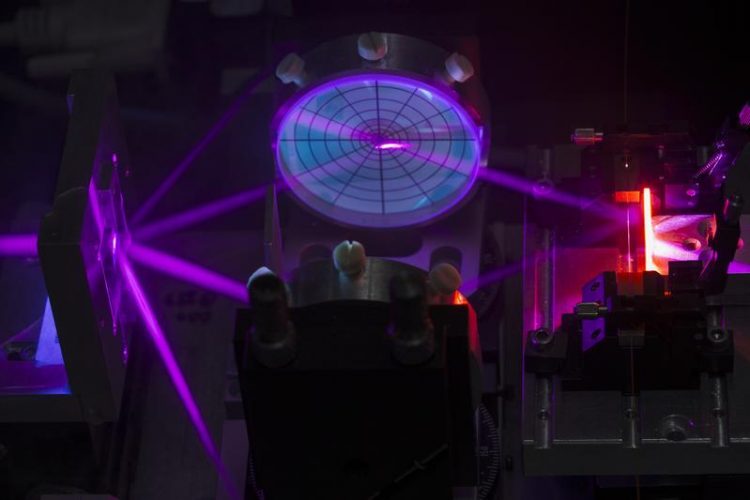Gentle diagnosis of esophageal diseases

Interferometer to write fiber Bragg gratings into the fiber core Sven Döring / Leibniz-IPHT
In order to find out how the complex interaction of the oesophagus muscles is disturbed, a measuring catheter determines the pressure distribution over the entire length of the oesophagus.
With fiber optic sensors, the scientists from Leibniz IPHT engineer high-resolution catheters that are no thicker than 4 millimeters. This simplifies the application and makes the measurement more comfortable for the patient.
In order to simultaneously measure the pressure at many different points of the esophagus and thus be able to analyze the peristaltic movements, the researchers arrange ten to fifteen fiber-optic “strain gages” — so-called fiber Bragg grating sensors — in an optical fiber.
Different wavelengths of the individual sensors determine at which points the measurements are carried out. Thanks to additional fiber-optic sensors in the area of the stomach and above, the catheter can simultaneously determine and link pressure, pH and bile values. This enables doctors to gain new insights into the causes of diseases.
The catheter is connected to a handy device, so that patients will be able to use it at home for measurements over a longer period of 24 hours and more. This will enable doctors to detect disorders that occur only occasionally.
“We have already reached a relatively high technology readiness level,” says fiber researcher and technologist Manfred Rothhardt, who coordinates the project and has been researching fiber-optic sensors at Leibniz IPHT for many years. In two years' time, he and his team plan to present the diagnostic device, which will then be tested on patients for over a year.
For the project entitled Optimo (OPTIcal fiber device for simultaneous manometry, pH-metry and bilimetry in Oesophagus), the research team is working with the companies Jenaer Technische Instrumente (JETI) and Oscomed from Sonneberg as well as with partners from the Italian CNR Institute for Applied Physics in Sesto Fiorentino, the University of Florence and Cecchi Srl, also based there. The German Federal Ministry of Education and Research is funding the research project with approximately 650,000 euros over the next three years as part of the EU “PhotonicSensing” program.
Manfred Rothhardt
Leibniz Institute of Photonic Technology, Jena
Department: Fiber Research and Technology
+49 (0) 3641 · 206-213
manfred.rothhardt(a)leibniz-ipht.de
https://www.leibniz-ipht.de/en/institute/presse/news/detail/speiseroehren-erkran…
Media Contact
All latest news from the category: Medical Engineering
The development of medical equipment, products and technical procedures is characterized by high research and development costs in a variety of fields related to the study of human medicine.
innovations-report provides informative and stimulating reports and articles on topics ranging from imaging processes, cell and tissue techniques, optical techniques, implants, orthopedic aids, clinical and medical office equipment, dialysis systems and x-ray/radiation monitoring devices to endoscopy, ultrasound, surgical techniques, and dental materials.
Newest articles

Superradiant atoms could push the boundaries of how precisely time can be measured
Superradiant atoms can help us measure time more precisely than ever. In a new study, researchers from the University of Copenhagen present a new method for measuring the time interval,…

Ion thermoelectric conversion devices for near room temperature
The electrode sheet of the thermoelectric device consists of ionic hydrogel, which is sandwiched between the electrodes to form, and the Prussian blue on the electrode undergoes a redox reaction…

Zap Energy achieves 37-million-degree temperatures in a compact device
New publication reports record electron temperatures for a small-scale, sheared-flow-stabilized Z-pinch fusion device. In the nine decades since humans first produced fusion reactions, only a few fusion technologies have demonstrated…





















